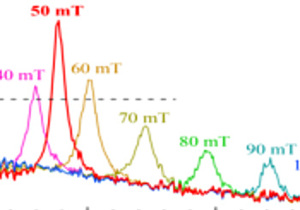Due to the nanometer size of magnetic tunnel junctions and high interfacial resistance of ultrathin MgO tunnel barriers, temperature modulation at GHz frequency can be achieved in these devices and efficiently use to amplify microwaves in spintronics oscillators.
Spintronics oscillators use two major phenomena discovered in spin-electronics: the tunnel magnetoresistance of magnetic tunnel junctions (MTJ) (i.e. the dependence of their electrical resistance on their magnetic configuration) and the spin transfer torque (i.e. the ability to modify the magnetic configuration by the current flowing through the magnetic tunnel junction). In this study, we demonstrated that a third phenomenon can be used to actually amplify a radiofrequency (RF) signal based on the RF temperature modulation of the MTJ. To achieve this, both a DC current and a weak RF current at a frequency close to the MTJ ferromagnetic frequency are sent through the tunnel junction. Due to the spin transfer phenomenon, the DC current triggers an oscillation of the magnetic configuration of the MTJ and the frequency of this oscillation locks at the frequency of the injected RF signal. Due to the tunnel magnetoresistance, the RF oscillation of the magnetic configuration yields a RF oscillation of the MTJ electrical resistance and correlatively a RF oscillation of the Joule heating dissipated in the junction. In this study, the MTJ was designed with double MgO tunnel barrier to increase the heat confinement between the two barriers. As a result, a RF modulation of the temperature of several degrees could be achieved in the heart of the tunnel junction. This temperature modulation yields a RF modulation of the magnetic anisotropy of the junction resulting in a significant enhancement and even amplification of the RF signal produced by the junction.
This work was performed in collaboration between Osaka Univ, AIST Japan, and SPINTEC.
a) Magnetic tunnel junction used for the experiments. It consists of a magnetically soft magnetic layer (FeB) sandwiched between two MgO tunnel barriers and a pinned reference magnetic layer (CoFeB)
b) Simulations showing the temperature modulation at the heart of the tunnel junction i.e. at the FeB layer inserted between the two MgO barriers.
c) microwave amplification coefficient (S11). In the range of bias field between 40 and 60mT, it exceeds 1 showing RF amplification.
Team: Theory and Simulation
Further reading: Microwave amplification in magnetic tunnel junction induced by heat-to-spin conversion at nano-scale, Minori Goto, Yosuke Wakatake, Ugwumsinachi Kalu Oji, Shinji Miwa, Nikita Strelkov, Bernard Dieny, Hitoshi Kubota, Kay Yakushiji, Akio Fukushima, Shinji Yuasa, and Yoshishige Suzuki, Nature Nanotechnology (2018).
Contact: bernard.dieny@cea.fr

